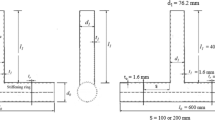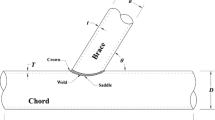Abstract
This paper reports the strength reduction factors of cracked multi-planar tubular DT-joints subjected to three simple loadings. The three strength reduction factors are used to calculate the static strength of the cracked tubular DT-joints and they have never been reported in any reference. Mesh of the cracked tubular DT-joints is created using a set of mesh generation code, and then FE (Finite Element) analyses are carried out using commercial software. The strength reduction factor is defined as the ratio of the static strength of the cracked joint over the uncrack joint. The effect of the crack area on the static strength of tubular DT-joints is investigated prudently. It is found that when the crack area is 25% of the product of chord thickness and weld length, the static strength of the cracked tubular DT-joint can decrease more compared to the corresponding uni-planar tubular T-joint, and the decrease magnitude is up to 23.2%, 37.4% and 31.2% of the static strength of the uncracked tubular DT-joint for axial tensile, IPB (In-Plane Bending) and OPB (Out-of-Plane Bending) loading, respectively. Finally, based on the FE results, three linear equations are recommended for calculating the strength reduction factors of cracked tubular DT-joints.
Similar content being viewed by others
References
ABAQUS (2011). Standard user’s manual, version 6.11, HibbeDT, Karlsson & Sorensen, Inc., USA.
Ahmadi, H. and Asoodeh, S. (2016). “Parameter study of geometrical effects on the Degree of Bending (DOB) in offshore tubular K-joints under out-of-plane bending loads.” Applied Ocean Research, Vol. 58, pp. 1–10, DOI: 10.1016/j.apor.2016.03.004.
API–RP–2A–WSD (2005). Recommended practice for planning, designing and constructing fixed offshore platforms-working stress design, America Petroleum Institute, Washington, USA.
API 579–1/ASME FFS–1 (2007). Fitness-for-service, American Society of Mechanical Engineers, Washington, USA.
BS7910:2013+A1:2015 (2015). Guide to methods for assessing the acceptability of flaws in metallic structures, British Standards Institution, London, UK.
Burdekin, F. M. (2002). The static strength of cracked joints in tubular members, Offshore Technology Report-2001/080, Healthy and Safety Executive, London, UK.
Chen, Y., Feng, R., and Fu, L. Q. (2017). “Investigation of grouted stainless steel SHS tubular X-and T-joints subjected to axial compression.” Engineering Structures, Vol. 150, No. 11, pp. 318–333, DOI: 10.1016/j.engstruct.2017.07.052.
Choo, Y. S., Qian, X. D., and Wardenier, J. (2006). “Effects of boundary conditions and chord stresses on static strength of thick-walled CHS K-joints.” Journal of Constructional Steel Research, Vol. 62, No. 4, pp. 316–382, DOI: 10.1016/j.jcsr.2005.08.001.
Eurocode 3 (2005). Design of steel structures–Part 1-8: Design of joints, British Standards Institution, London, UK.
Gho, W. M., Gao, F., and Yang, Y. (2006). “Strain and stress concentration of completely overlapped tubular CHS joints under basic loadings.” Journal of Constructional Steel Research, Vol. 62, No. 7, pp. 656–674, DOI: 10.1016/j.jcsr.2005.11.009.
Laham, S. A. L. and Burdekin, F. M. (1997). The ultimate strength of cracked tubular K-joints, Offshore Technology Report-OTH 497, Healthy and Safety Executive, London, UK.
Li, T., Lie, S. T., and Shao, Y. B. (2017). “Fatigue and fracture strength of a multi-planar circular hollow section TT-joint.” Journal of Constructional Steel Research, Vol. 129, pp. 101–110, DOI: 10.1016/j.jcsr.2016.11.001.
Lie, S. T., Li, T., and Shao, Y. B. (2014). “Plastic collapse load prediction and failure assessment diagram analysis of cracked circular hollow section T-joint and Y-joint.” Fatigue & Fracture of Engineering Materials & Structures, Vol. 37, No. 3, pp. 314–324, DOI: 10.1111/ffe.12115.
Lie, S. T., Li, T., Shao, Y. B., and Vipin, S. P. (2016). “Plastic collapse load prediction of cracked circular hollow section gap K-joints under in-plane bending.” Marine Structures, Vol. 50, pp. 20–34, DOI: 10.1016/j.marstruc.2016.06.002.
Lu, L. H., de Winkel, G. D., Yu, Y., and Wardenier, J. (1994). “Deformation limit for the ultimate strength of hollow section joints.” Proceedings of the 6th International Symposium on Tubular Structures, Melbourne, Australia, pp. 341–348.
Paul, J. C., Makino, Y., and Kurobane, Y. (1993). “Ultimate resistance of tubular double T-joints under axial brace loading.” Journal of Constructional Steel Research, Vol. 24, No. 3, pp. 205–228, DOI: 10.1016/0143-974X(93)90044-S.
Qian, X. D. (2013). “Failure assessment diagrams for circular hollow section X-and K-joints.” International Journal of Pressure Vessels and Piping, Vol. 104, pp. 43–56, DOI: 10.1016/j.ijpvp.2013.01.004.
Qian, X. D., Li, Y., and Ou, Z. Y. (2013). “Ductile tearing assessment of high-strength steel X-joints under in-plane bending.” Engineering Failure Analysis, Vol. 28, pp. 176–191, DOI: 10.1016/j.engfailanal.2012.10.017.
Scola, S., Redwood, R. G., and Mitri, H. S. (1990). “Behaviour of axially loaded tubular V-joints.” Journal of Constructional Steel Research, Vol. 16, No. 2, pp. 89–109, DOI: 10.1016/0143-974X (90)90015-9.
Shao, Y. B. (2007). “Geometry effect on the stress distribution along weld toe for tubular T-and K-joints under axial loading.” Journal of Constructional Steel Research, Vol. 63, No. 10, pp. 1351–1360, DOI: 10.1016/j.jcsr.2006.12.005.
Shao, Y. B. (2008). “Study of the stress distribution along the weld toe for tubular TT-joints subjected to axial tensile loads.” Journal of Mechanical Strength (in Chinese), Vol. 30, No. 2, pp. 244–249.
Shen, W. and Choo, Y. S. (2012). “Stress intensity factor for a tubular Tjoint with grouted chord.” Engineering Structures, Vol. 35, pp. 37–47, DOI: 10.1016/j.engstruct.2011.10.014.
Stacey, A., Sharp, J. V., and Nichols, N. W. (1996a). “Static strength assessment of cracked tubular joints.” Proceeding of the 15th International on Offshore Mechanics and Arctic Engineering, Florence, Italy, Vol. 3, pp. 211–224.
Stacey, A., Sharp, J. V., and Nichols, N. W. (1996b). “The influence of cracks on the static strength of tubular joints.” Proceeding of the 15th International on Offshore Mechanics and Arctic Engineering, Florence, Italy, Vol. 3, pp. 435–450.
Tong, L. W., Xu, G. W., Yang, D. L., Mashiri, F. R., and Zhao, X. L. (2017). “Stress concentration factors in CHS-SFSHS T-joints: Experiments, FE analysis and formulae.” Engineering Structures, Vol. 151, pp. 406–421, DOI: 10.1016/j.engstruct.2017.07.077.
Van der Vegte, G. J., Makino, Y., Choo, Y. S., and Wardenier, J. (2001). “The influence of chord stress on the ultimate strength of axially loaded uniplanar X-joints.” Proceedings of the 9th International Symposium and Euroconference on Tubular Structures, Dusseldorf, Germany, pp. 165–174.
Wang, Y. M., Shao, Y. B., Song, S. Z., and Yang, D. P. (2017). “Static test on failure process of tubular T-joints with initial fatigue crack.” Steel and Composite Structures, Vol. 24, No. 5, pp. 615–633, DOI: 10.12989/scs.2017.24.5.615.
Wardenier, J., Kurobane, K., Packer, J. A., van der Vegte, G. J., and Zhao, X. L. (2008). Design guide for circular hollow section (CHS) joints under predominantly static loading–2nd edition, CIDECT Publication No.1, TUV-Verlag, Germany.
Zerbst, U., Heerens, J., and Schwalbe, K. H. (2002). “The Fracture behavior of a welded tubular joint-an ESIS TC1.3 round robin on failure assessment methods Part I: experimental data base and brief summary of the results.” Engineering Fracture Mechanics, Vol. 69, No. 10, pp. 1093–1110, DOI: 10.1016/S0013-7944(01)00140-0.
Zhao, X. L. (2000). “Deformation limit and ultimate strength of welded T-joints in cold-formed RHS sections.” Journal of Constructional Steel Research, Vol. 53, No. 3, pp. 149–165, DOI: 10.1016/S0143-974X(99)00063-2.
Author information
Authors and Affiliations
Corresponding author
Rights and permissions
About this article
Cite this article
Li, T., Lie, S. Strength Reduction Factors for Cracked Multi-planar Tubular DT-joints. KSCE J Civ Eng 23, 307–320 (2019). https://doi.org/10.1007/s12205-018-0547-z
Received:
Revised:
Accepted:
Published:
Issue Date:
DOI: https://doi.org/10.1007/s12205-018-0547-z




